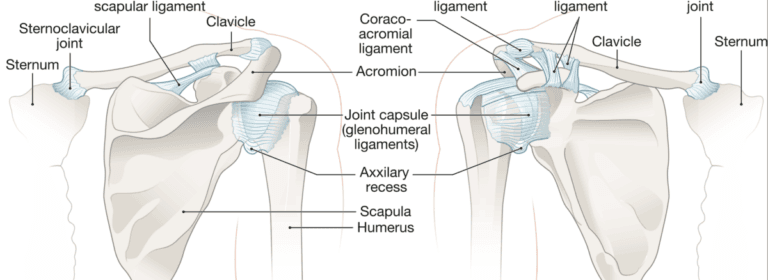The sternoclavicular (SC) joint is one of the four joints that complete the shoulder. The joint is located in the spot where the clavicle (collarbone) meets the sternum (breastbone) at the base of the neck. Although not common, problems with the SC joint can arise from injury and other disorders.
Injuries to the SC joint typically result from motor vehicle accidents or participation in collision sports like football. While these injuries can be painful, most are relatively minor and will heal well without surgery. Very rarely, a hard blow to the SC joint can damage the vital organs and tissues that lie nearby. When this occurs, it is a serious injury that requires immediate medical attention.
The SC joint can also be damaged over time, as the protective tissue that covers the ends of the bones gradually wears away. This type of degenerative change in the joint can lead to pain, stiffness, and reduced motion in the shoulder and arm
Anatomy
The sternoclavicular (SC) joint is one of the four joints that complete the shoulder. The joint is located in the spot where the clavicle (collarbone) meets the sternum (breastbone) at the base of the neck. Although not common, problems with the SC joint can arise from injury and other disorders.
Injuries to the SC joint typically result from motor vehicle accidents or participation in collision sports like football. While these injuries can be painful, most are relatively minor and will heal well without surgery. Very rarely, a hard blow to the SC joint can damage the vital organs and tissues that lie nearby. When this occurs, it is a serious injury that requires immediate medical attention.
The SC joint can also be damaged over time, as the protective tissue that covers the ends of the bones gradually wears away. This type of degenerative change in the joint can lead to pain, stiffness, and reduced motion in the shoulder and arm.
Description
Injuries and osteoarthritis are the most common disorders associated with the SC joint.
Injuries
Injuries to the SC joint can range from a mild sprain, in which the surrounding ligaments are stretched (the most commonly seen injury), to a fracture of the clavicle (collarbone) itself. In rare cases, a strong blow to the shoulder can cause an injury in which the joint dislocates completely from its normal position. Joint dislocations are classified as either “anterior” or “posterior,” depending on the direction in which the collarbone is pushed during the injury:
Although both kinds of dislocations are serious injuries, a posterior dislocation requires more urgent medical attention. In a posterior dislocation, the vital structures behind the SC joint can be compressed, leading to life-threatening problems with breathing or blood flow.
Causes of injury.
The ligaments surrounding the SC joint are some of the strongest in the body, so it takes a great deal of force to cause an injury. Typically, injuries to the joint are caused by some type of high-impact event, such as a:
• Collision or hard fall during a contact sport like football or rugby
• Motor vehicle accident
Because of the significant force needed to cause an injury, patients may also have additional injuries to the chest, airways, and extremities. In some cases, injury to the SC joint is overlooked at first because these other injuries require urgent attention.
Osteoarthritis
Osteoarthritis is a degenerative “wear and tear” type of arthritis that occurs most often in people 50 years of age or older, though it may occur in younger people, too. In osteoarthritis, the smooth articular cartilage that covers the SC joint gradually wears away. As the cartilage wears away, it becomes frayed and rough, and the protective space between the bones decreases. This can result in painful bone rubbing on bone and can also lead to a bony prominence around the joint. Osteoarthritis develops slowly and the pain and stiffness it causes worsens over time.
Other Disorders
Other disorders associated with the SC joint include:
In addition, some patients may experience slight movement or popping of the bone out of place even without some type of trauma. This condition is called “subluxation” and seems to be limited to those people who are considered “loose jointed.”





